
Gijón is located along the Bay of Biscay, between Cape Thompson and the tip of Cervigón, and between South Bay and Santa Catalina de Gijón or San Lorenzo. The first human settlement in Gijon V century BC C., in Campa Torres, where they founded the town called Cilúmigos Noega.
After the Roman conquest did the primitive village in the heart of Santa Catalina in the century l a. C. Protected by the wall, the medieval village was to the port and in the eighteenth century became the main maritime capital growing in Asturias. Since then, industrial development was the constitution as the largest city in Asturias.
Route:
For Gijón we visit first the important archaeological remains found in Campa Torres, its Roman walls and baths in Campo Valdés where we will discover the lifestyle of its residents in the Roman period.
Already in Gijón monumental, we began the route Cimadevilla neighborhood where we can appreciate the uniqueness of many of its buildings include the house of Jove Ramirez (sixteenth century), the convent and church of the Augustinians (XV century) and the former tobacco factory. High in the district at the Cerro de Santa Catalina, is the «Elogio del Horizonte» (1989), by Eduardo Chillida.
In this palace Campo Valdés Valdés (s.XVll) and the church of St. Peter, overlooking the Bay of Biscay (XV century) and restored in 1955. Of interest are the houses of the Llanos Valdes and Nava.
On the street we can admire Cabrales Jove Hevia tower and the Chapel of San Lorenzo, whose facade accuses the effects of salinity.
In the plaza of the Museum-Jovellanos Jovellanos birthplace, which evokes the figure of the Enlightenment and the Plaza Mayor are the Town Hall, a neoclassical style. Across the Plaza Mayor to the Marina we see on our right, the Palace of Revillagigedo and the collegiate church of San Juan, superbly refurbished. Presiding over the square a monument to Pelayo. Near this museum dedicated to John Barjola, located in the palace-house of Jove Huergo.

Jovellanos in the street, corner of the square stands the Royal Institute of Jovellanos Institute, which houses the Center for Culture Old Institute. Other significant buildings are the former Fish Market and South Market.
On some streets of Gijon, as Capua, Cabrales or Corrida buildings are beautiful examples raised in the industrial boom of the early twentieth century, as the Central Bank building between The Moors and Munuza. We must not miss the square of the Institute, known as Parcheesi Square and the Plaza de San Miguel, ellipsoidal design.
On the walk from the beach of San Lorenzo we reached the bridge of the piles, the Parque Hermanos Castro, the compound of the International Trade Fair of Asturias and the Museum of Asturias. On the other side of the river, The Molinón Stadium and La Plaza de Toros, neo-Mudejar. We can continue along the promenade of El Rinconín, magnificently restored, down to the beach of Nora.
On the outskirts of Gijón can visit natural areas and sets of traditional architecture in Deva. In Cabueñes in the old Technical College opened in the fifties, notable for its size (its tower reaches 120 meters high), are Education and Culture City Education Center for Art and Industrial Creation. Directly opposite lies the Botanic Garden, in the same parish, you can practice Cabueñes harvest.
The Romanesque is present in Ceara and CENER where we can see beautiful examples of medieval architecture in the church of San Andrés de Ceara (s.Xll or XIII) and San Juan de Cenera. Distinctive features are the Caldones San Vicente, Santa Eulalia de Valdornón, San Juan and San Miguel Fano Serin.
After the tour of the historic and artistic heritage of Gijon and the surrounding area, visitors can take a breath and close to one of the beaches in the area, those of San Lorenzo, where are the West Aquarium and the Thalassotherapy Center, Arbeyal and, in the city, or Peñarrubia, serine and Nora.
The rich and varied cuisine, accompanied by good cider, is certainly another attraction of this area, which also stands out for its crowded environment, especially in summer. Along with the pilgrimages of the surrounding villages, Gijón wears his best clothes to celebrate the feast of Our Lady of Begoña (August 15) or Antroxu (carnival). Known are also the Semana Negra, Latin American Book Fair, the International Film Festival and the International Trade Fair, which during the summer in the city brings many visitors. The last weekend of August, the Natural Cider Festival, a festival of tourist interest in the Principality of Asturias.

Bon voyage!
Leave a Reply
You must be logged in to post a comment.
Recent Comments